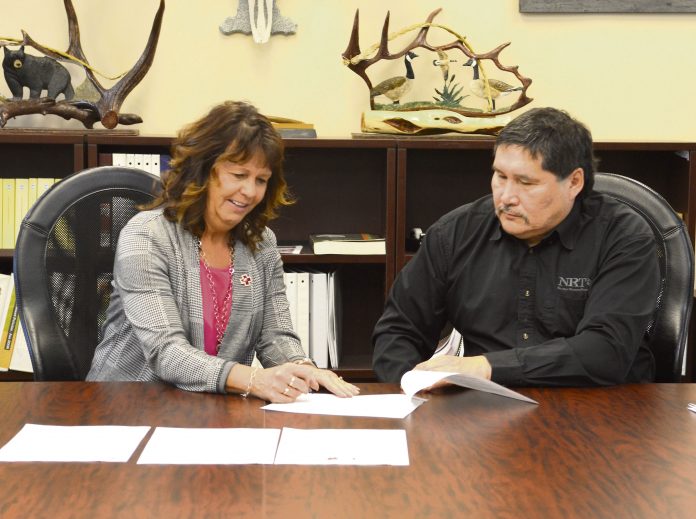
The Red Cross and the Prince Albert Grand Council (PAGC) signed a historic agreement Friday to formalize their relationship in evacuation planning and response. The agreement is the first of its kind in Saskatchewan.
While the agreement is not legally binding, it does put down ion paper how each organization can work together to support each other and take advantages of all the resources available. It also ensures an open, working relationship through clear and regular communications.
“We’re happy with what we’ve reached here,” said PAGC Grand Chief Brian Hardlotte.
“It’s a significant step forward in building a more cooperative and collaborative relationship between the Prince Albert Grand Council and the Red Cross. This agreement means, during the time of emergency, we will be able to participate and contribute in planning and working together towards our common goal — providing the best support and services to those affected by emergencies in northern communities.”
Hardlotte took the time to thank the efforts of the Red Cross during past evacuations, whether due to wildfire or flooding. He also thanked staff and volunteers from several PAGC communities who have come together during those tough times to provide services to those displaced due to natural disasters.
“Our communities are so close-knit,” Hardlotte said.
“When one is in need, we treat each other like an extended family.”
Hardlotte said that through this agreement communication will improve, and the Grand Council will work hard to recruit and train volunteers and communities to plan for future emergencies. He also said the PAGC will work to certify community facilities such as schools and health clinics, upgrading air exchanges so more people effected by wildfire smoke can stay in their home communities.
“I’m positive the new agreement will allow us to work more collaboratively with one another to make the most out of difficult situations,” he said.
“Communication will improve, and we’ll be more actively involved at the community level. This set s a strong foundation on the principles of respect, trust and understanding, and cultural sensitivity.”
Officials from the Red Cross said this agreement will help to better prepare the organization to respond to unique needs of northern Indigenous communities in the case of an evacuation.
“We recognize … that communities know their communities best,” said Cindy Fuchs, vice president of the Canadian Red Cross in Saskatchewan.
“We have a lot to share with how we work even closer together, in a way that recognizes cultural sensitivities, making it much safer and a better opportunity for those that are evacuated and in crisis.”
According to Kim MacLean, Red Cross director of disaster management in Saskatchewan, the end goal is to build capacity so PAGC can take the lead in times of crisis.
“We acknowledge while we have some expertise in disaster, we also acknowledge the expertise and knowledge of these communities,” she said.
‘We know there’s a lot of traditional knowledge around disaster and around prevention, so we have to look at how we can access and use that to build community resilience so perhaps we aren’t always moving people out. Perhaps we can keep them in their communities.”
Preventing evacuations is also a key focus of the PAGC. The organization is working with the province to change the way wildfires are managed with the hopes of keeping elders and those with health conditions at home when fires start to rage.
“The forest we live in … is very, very old. Any forest that becomes old, it’s like a cycle. It will burn. It’s just a matter of time.”
The old forest with lots of dead and drying trees is very “volatile,” Hardlotte said. With climate change extending wildfire seasons, the problem is only getting worse. Up until about 23 years ago, the First Nations handled the wildfire responses themselves. Then, the government stepped in to ensure resources were consistent across the region, Hardlotte said.
The PAGC and the Red Cross worked together in times of crisis, but both organizations have realized that’s not enough.
“We didn’t know a lot,” MacLean said.
“Historically … if you look to the impact of disasters over the last ten years, I would say the majority of the impact is on Indigenous communities in our province.”
MacLean said communities are unique with different vulnerabilities, and the Red Cross has had to learn how to work in a way that’s respectful and provides needed services.
“We’ve had evacuations where we’re trying to listen to communities and feedback from leadership and it really isn’t going so well. We think there’s a better way to do this, and we want to be a part of the solution,” she said.
“When the scope and type of activities was smaller, we could be a little more informal. Going forward, what we hope for is we’re a support. It’s the community that leads this, not the Red Cross. We need to work on our readiness, we acknowledge we need to learn a lot more, and that’s how we want to go forward.”

